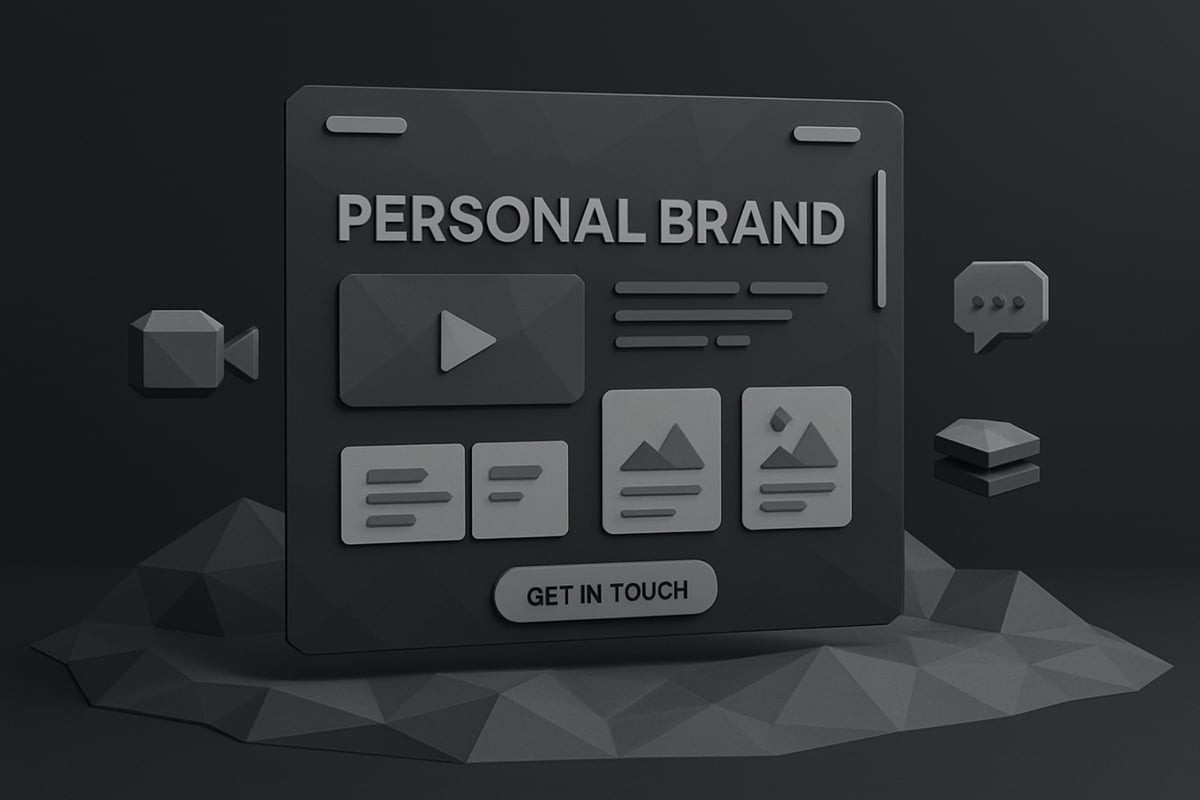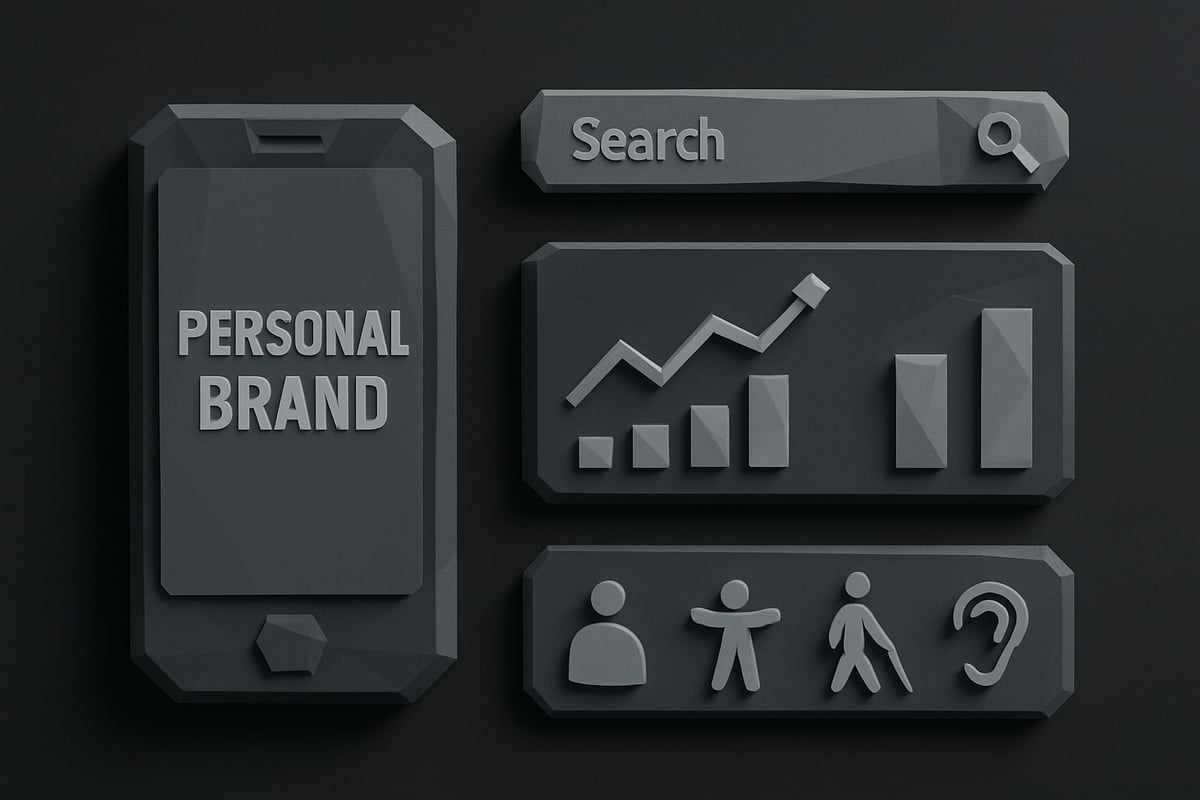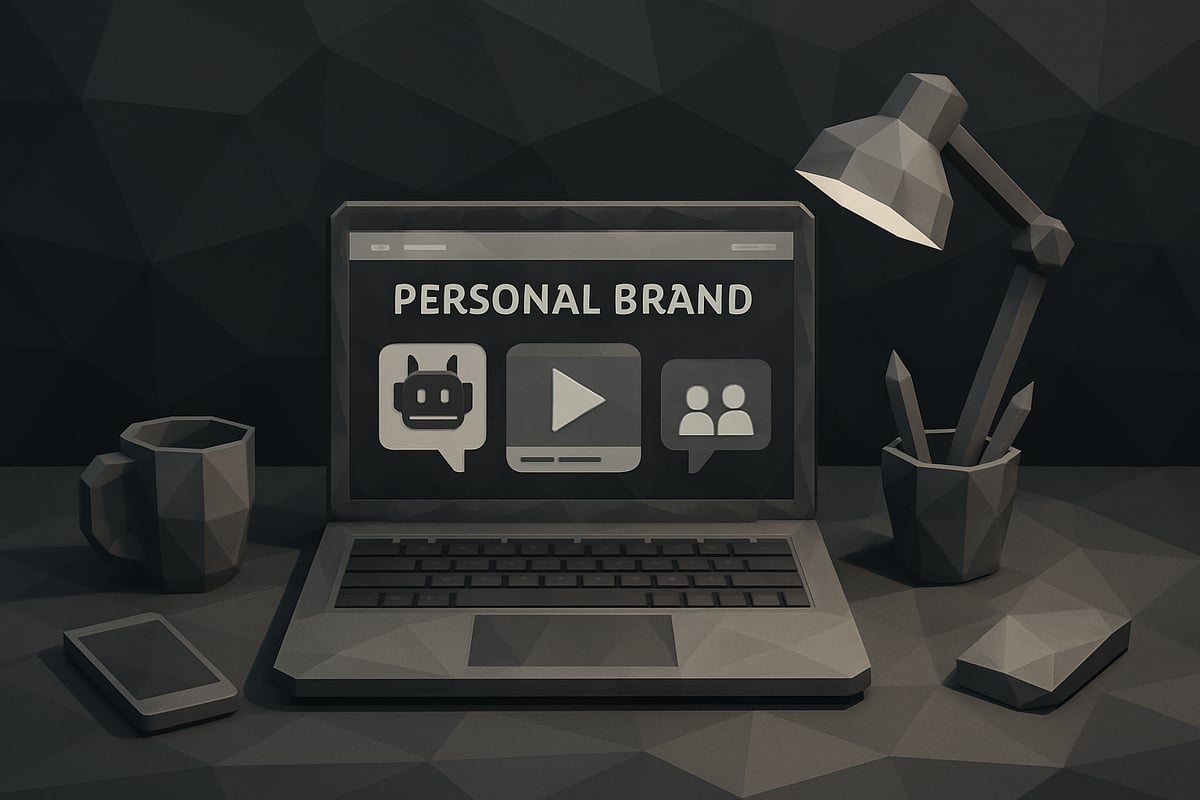In 2025, having a personal brand website is no longer optional for professionals, creators, or entrepreneurs. Your online presence is your strongest asset in a digital world that values authenticity and expertise. This article will introduce eight inspiring personal brand website ideas designed to help you stand out and thrive.
You’ll discover innovative layouts, interactive portfolios, powerful storytelling, smart automation, and designs that boost conversions. Ready to future-proof your online presence? Let’s explore what it takes to build or revamp a personal brand website that truly sets you apart.
Why Personal Brand Websites Matter in 2025
The digital world in 2025 is more competitive and fast-moving than ever. Whether you’re an entrepreneur, freelancer, or creative, standing out is non-negotiable. A personal brand website has shifted from a nice-to-have to an essential tool for anyone who wants to build authority, attract opportunities, and future-proof their career.

The Evolving Digital Landscape
The professional landscape has changed dramatically. Remote work, the creator economy, and digital entrepreneurship are reshaping how we connect, work, and thrive. In fact, 36% of the U.S. workforce freelanced in 2023, up from 28% in 2019. This surge reflects a growing need for a strong personal brand website to showcase expertise and attract clients. For more up-to-date insights, check out these Personal Branding Statistics 2025.
Why is owning your platform so important? Social media is crowded and algorithms change constantly. With a personal brand website, you control your message, design, and user experience. This means you build credibility and can nurture long-term growth, rather than being at the mercy of a third party’s rules.
AI and automation are also transforming how personal brands connect and convert. Smart chatbots, automated email sequences, and dynamic content recommendations can turn a personal brand website into a 24 7 engagement engine. These tools allow solopreneurs to scale their reach and provide personalized experiences without hiring a huge team.
Today’s personal brand website is far more than a digital resume. It acts as a central hub for content, digital products, and community building. Many successful creators use their sites to launch courses, sell ebooks, or host exclusive member spaces. This approach turns their personal brand website into a scalable business, not just an online portfolio.
SEO and discoverability trends are evolving too. Google increasingly rewards sites that demonstrate real-world experience, expertise, authoritativeness, and trustworthiness (E-E-A-T). By consistently publishing valuable content and sharing your unique story, your personal brand website can climb search rankings and attract organic traffic from high-intent audiences.
Let’s look at a few examples. Creators like Gary Vaynerchuk and Jasmine Star have leveraged their personal brand website as a launchpad for products, communities, and massive audience growth. Their success stories show that an investment in your own platform pays dividends in credibility, trust, and income.
In summary, a personal brand website is no longer optional in 2025. It’s the foundation for building authority, earning trust, and unlocking new streams of scalable income. The digital landscape will keep evolving, but one thing is clear: your personal brand website is your most powerful asset.
8 Inspiring Personal Brand Website Ideas for 2025
Ready to make your mark online? A personal brand website in 2025 is more than a digital business card—it’s your interactive storefront, portfolio, and community hub. The best sites blend innovation, engagement, and strategy. Let’s explore eight standout ideas that will help your personal brand website shine this year.

1. Interactive Storytelling Homepages
Imagine landing on a personal brand website where your journey unfolds like an interactive storybook. In 2025, immersive visuals, subtle animations, and scroll-triggered effects can turn a simple introduction into an unforgettable experience.
Take Robby Leonardi’s interactive resume, for example. His site transforms his career path into a gamified adventure. Visitors scroll through colorful scenes, discover milestones, and engage with clickable “chapters.” The result? People remember his story, and his personal brand website stands out from static alternatives.
- Tips for your site:
- Use animated timelines or parallax backgrounds to highlight key achievements.
- Add micro-interactions, like hover effects or clickable icons, for subtle engagement.
- Break your story into interactive sections for easy navigation.
Data shows that websites with interactive elements see up to 30% higher engagement rates. Even minimalist sites can make an impact with micro-interactions. Personal stories foster emotional connections, turning your personal brand website into a memorable destination.
2. Conversion-Driven Lead Magnets & CTAs
A personal brand website should never leave visitors guessing what to do next. Clear, compelling calls-to-action (CTAs) guide users to sign up for newsletters, grab free resources, or book a call. Louise Henry’s homepage, for instance, uses a focused CTA for webinar signups, making the user journey seamless.
- Tactics for higher conversions:
- Place one primary CTA per page to avoid confusion.
- Use sticky bars, exit-intent popups, or value-packed lead magnets.
- Offer personalized CTAs for different audience segments.
Personalized CTAs convert 202 percent better than generic ones. Every personal brand website should prioritize growing an audience. If you need inspiration, check out these lead magnet ideas for websites that attract and convert visitors.
The right CTA turns your personal brand website from a static page into a lead-generating machine.
3. Dynamic Portfolio Showcases
Your work deserves the spotlight. A personal brand website in 2025 thrives on dynamic, filterable portfolio sections. Whether you’re a designer, consultant, or coach, showcasing your best projects builds instant credibility.
Consider Daniel Grindrod’s videography site. He features project samples, kit breakdowns, and even before-and-after sliders. Visitors can filter work by type, making it easy to find relevant examples.
- Showcase tactics:
- Add client testimonials next to each project.
- Use “featured project” carousels for top work.
- Incorporate video, audio, or interactive previews.
Sites with portfolio sections see up to 40 percent more inquiries. Even if you’re not a creative, use case studies to illustrate your impact. A compelling portfolio transforms your personal brand website into proof of your expertise.
4. Personalization & AI-Powered Experiences
AI isn’t just a buzzword—it’s a game-changer for the modern personal brand website. Imagine greeting visitors by name, recommending resources based on their activity, or answering questions via chatbot.
Some personal brand websites already use AI chatbots for instant support or dynamic greetings based on location. Others suggest blog posts or products tailored to a visitor’s interests.
- Simple AI upgrades:
- Integrate a chatbot for FAQs or scheduling.
- Personalize homepage greetings based on user data.
- Offer content or product recommendations powered by AI.
Personalized experiences can increase conversion rates by 10 to 20 percent. Even solo brands can scale interactions with automation. A touch of personalization makes every visitor feel valued, setting your personal brand website apart.
5. Authentic “About” Pages with Multimedia
People want to know the real you. The “About” page on your personal brand website is a top destination—so make it unforgettable. Go beyond a wall of text with video intros, audio snippets, or interactive timelines.
Geraldine DeRuiter’s site is a great example. Her quirky storytelling, custom graphics, and fun facts draw readers in. Authenticity and vulnerability resonate far more than generic bios.
- Tips for a standout About page:
- Use professional photography or casual, behind-the-scenes shots.
- Share “fun facts” or a quick video introduction.
- Embed interviews or audio messages for a personal touch.
About pages are among the top three most-visited sections of any personal brand website. Multimedia helps visitors connect and remember you, building trust from the very first click.
6. Seamless Contact & Booking Integrations
When your audience is ready to connect, your personal brand website should make it effortless. Seamless contact forms, live chat, and booking calendars reduce friction and boost inquiries.
Louise Henry’s site features a contact page with FAQs and instant email buttons. Even better, smart forms segment leads by interest, while embedded calendars allow visitors to schedule calls instantly.
- Integration ideas:
- Use multi-step forms to filter inquiries.
- Offer instant booking for consultations or demos.
- Add live chat or messaging for quick questions.
Sites with embedded scheduling see 25 percent more bookings. User experience is everything—a smooth contact process turns visitors into loyal clients on your personal brand website.
7. Content Hubs & Resource Libraries
A personal brand website isn’t just a profile—it’s a content destination. Build a central hub for your best articles, videos, podcasts, or downloads. Gary Vaynerchuk’s site, for example, features podcasts, books, and event signups, creating a one-stop shop for his audience.
- Resource hub tactics:
- Organize content by topic, format, or audience.
- Highlight “best of” or “start here” sections for newcomers.
- Offer downloadable guides, templates, or mini-courses.
Content hubs boost return visits and improve SEO rankings. They also open doors for passive income—think digital products or affiliate links. Even the smallest personal brand website can start with a simple “resources” section and grow from there.
8. Bold, Branded Visual Identity
Your personal brand website should look as unique as you are. A bold visual identity—custom colors, dynamic fonts, and on-brand imagery—makes your site instantly recognizable.
Jasmine Star’s site is a masterclass in visual branding, from vibrant color palettes to consistent photography. But you don’t have to be a designer to stand out.
- Branding essentials:
- Choose a color palette that reflects your personality and niche.
- Use custom typography and consistent visual elements.
- Apply your branding across all pages and social channels.
Consistent branding can increase revenue by up to 23 percent. Great design isn’t just for designers—invest in professional branding or use high-quality templates to give your personal brand website a polished, memorable look.
Essential Features Every Personal Brand Website Needs
Building a standout personal brand website requires more than just eye-catching design. To succeed in 2025, your site must deliver on mobile performance, discoverability, accessibility, and analytics. Let us break down the features every personal brand website needs to thrive.

Mobile Optimization & Performance
A personal brand website must be flawless on mobile. With over 60 percent of web traffic coming from mobile in 2024, responsive design is non-negotiable. Your site should resize images, adapt layouts, and keep navigation simple for every screen size.
Fast load times are critical. Aim for under three seconds, since 53 percent of mobile users abandon slow sites. Use compressed images, lazy loading, and streamlined code to boost speed. For inspiration, check out Leah Goetzel’s photography site, which delivers mobile-friendly galleries and seamless user experience.
Test your personal brand website regularly with tools like Google PageSpeed Insights or GTmetrix. Prioritizing performance not only improves conversions but also enhances your brand’s reputation.
SEO & Discoverability
To attract the right audience, your personal brand website must be easy to find. Optimize meta titles, descriptions, and schema for each page. Use keyword-rich, natural language that reflects your expertise and voice.
Remember, 68 percent of online experiences begin with a search engine. Sites that rank for high-intent keywords like “best personal brand websites 2025” enjoy a steady stream of visitors. For actionable tips on SEO best practices, check out How to increase website traffic.
SEO is not a one-time task. Keep your personal brand website fresh with regular content updates, blog posts, and by building authority through guest appearances.
Accessibility & Inclusivity
Your personal brand website should welcome everyone. Make sure to add alt text to images, maintain strong color contrast, enable keyboard navigation, and use readable fonts. These steps ensure your content is usable by all visitors.
Fifteen percent of the world’s population lives with a disability. Sites with accessibility features reach wider audiences and demonstrate that inclusivity is a core part of your personal brand website. Audit your site with tools like WAVE or Axe to spot areas for improvement.
Accessible design is not just about compliance. It is about strengthening your brand’s impact and values.
Analytics & Continuous Improvement
A personal brand website should never be static. Use analytics tools like Google Analytics or Hotjar to track user behavior and refine your site over time. Set clear goals, such as increasing newsletter signups or client inquiries, and measure what matters.
Split-test headlines, CTAs, or page layouts to see what resonates with your audience. Data-driven sites iterate faster and convert better, turning your personal brand website into a true growth engine.
Continuous improvement keeps your site relevant, effective, and always aligned with your goals.
Future Trends in Personal Brand Website Design
What will shape the next evolution of your personal brand website? As digital habits shift and technology advances, staying ahead means embracing the trends that are set to define 2025. Let’s explore five key innovations that will keep your site fresh, engaging, and ready for the future.

AI & Automation
Artificial intelligence is transforming the way a personal brand website connects with visitors. Expect to see more smart chatbots, automated content suggestions, and tailored user journeys. For example, AI-driven personalization can greet users by name or recommend resources based on browsing behavior.
These tools not only enhance user experience but also help solo entrepreneurs scale interactions efficiently. In fact, 80% of marketers believe AI will revolutionize web experiences by 2025. If you want your personal brand website to stand out, integrating automation is a future-proof move.
Video-First Content
Short-form video is rapidly becoming the star of personal brand website design. Video intros on homepages and about pages instantly humanize your brand, while explainer clips make your message clearer. Research shows video can boost dwell time by up to 88%.
Embedding video also increases user trust and drives more conversions. As viewers crave authentic, face-to-face connection, investing in high-quality video content is one of the smartest ways to make your personal brand website memorable.
Community Building Features
Building a loyal audience is easier when your personal brand website includes community spaces. Private forums, Discord channels, or member-only areas encourage deeper engagement and ongoing conversation.
These features turn your site into a destination, not just a digital business card. Community-driven brands foster loyalty and recurring revenue, which is why more creators are adding exclusive Q&A sessions or live events for members. Want to learn why this matters? Check out these statistics that prove the value of personal branding.
Monetization & Digital Products
A top trend for 2025 is embedding digital products and e-commerce directly into your personal brand website. Whether you sell templates, guides, or courses, your site becomes a true sales engine, not just a portfolio.
Digital product sales are projected to grow 12% annually through 2027, making this a lucrative strategy. For inspiration and actionable steps, see this guide on building a digital product portfolio to showcase and sell your own offerings online.
Minimalism & Accessibility
Clean, uncluttered design is in. Minimalist layouts help visitors focus on what matters most, while fast load times improve both SEO and conversions. Accessibility is equally crucial—features like alt text, readable fonts, and strong color contrast make your personal brand website welcoming to all.
Minimalist and accessible sites load faster and reach wider audiences. In 2025, less is definitely more when it comes to creating a site that converts and leaves a lasting impression.
If you’re feeling inspired by these forward thinking personal brand website ideas and ready to make your mark online you don’t have to figure it all out alone We’ve covered everything from interactive storytelling to scalable digital product strategies and now it’s your turn to put these insights into action Whether you’re just starting or looking to upgrade your site CreateSell has the tools and expert guidance to help you build a brand and business that stands out in 2025 Curious how to get going Let’s take the first step together—Get Started